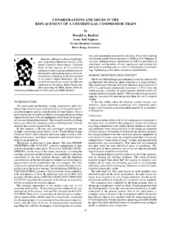| dc.description.abstract | The successful justification, design, installation, and commissioning of new major machinery in an existing petrochemical plant requires special consideration of many issues. This is particularly true in instances where existing machines are being replaced with state of the art equipment, which must be integrated into an existing infrastructure. The recognition of the pertinent issues, as well as the strategies used in handling them, directly impacts the overall success of the job. In this instance, a 20 year old centrifugal compressor and straight condensing steam turbine in the Exxon Baton Rouge Chemical Plant's main ethylene unit were replaced with a new, high performance centrifugal compressor and extraction/condensing steam turbine. The project is described in four phases. The first, DESIGN INCEPTION AND CONCEPT, contains explanations of how and why the project came about. The second, DESIGN DEVELOPMENT, covers many of the issues considered, including the existing machinery problem history, the installation's physical constraints on the new machine designs, and the logistical considerations of the installation environment and plant operating practices which would affect the new designs. The final compressor, steam turbine, and control system designs are described, as is the factory testing. The third phase, INSTALLATION PLANNING, includes a brief overview of the schedule, with descriptions of how the machines were to be lifted and mounted. The final phase, INSTALLATION EXECUTION AND STARTUP, describes the outcomes of the design and planning efforts covered in the previous phases. The strategic approaches to the project were key to it's evolution and success. These strategies are evident in the text descriptions of the project, with specific examples in the CONCLUSION. They were: 1) awareness of other project or optimization opportunities which could be economically integrated into the main project; 2) comparison of reused equipment performance with the state of the art; 3) testing of past conclusions regarding the viability of changes; 4) investigation of calculation and assessment assumptions in areas where the resulting conclusions could effect the project's viability; 5) willingness to use new, undemonstrated approaches to difficult problems; 6) intentional configuration of new equipment and systems for similarity to existing ones in order to aid operator understanding; 7) planning to minimize execution dependencies. | en |


